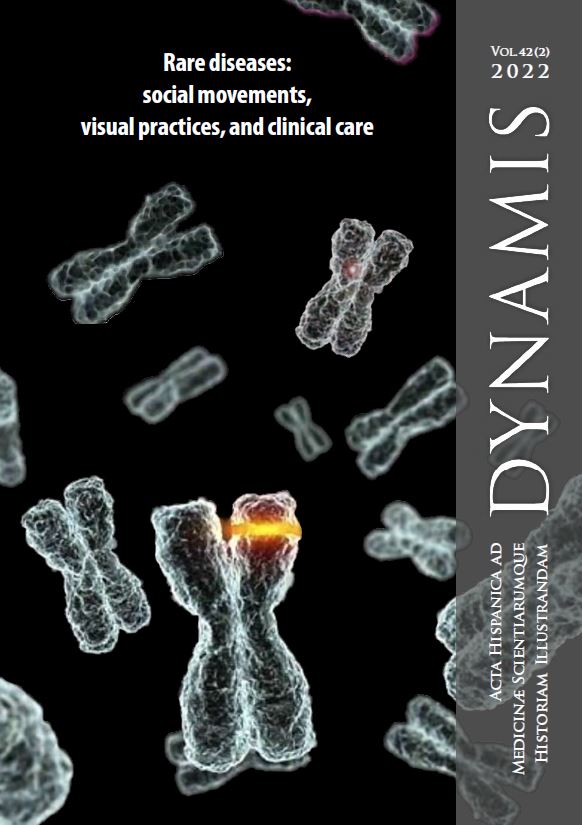A historical analysis of the policy on intractable diseases in Japan and its peculiarity
DOI:
https://doi.org/10.30827/dynamis.v42i2.27715Palabras clave:
Intractable Diseases, Rare Diseases, Patient Support Groups, SMON, Japan.Resumen
This article examines the history of the policy concerning a class of diseases called intractable diseases in Japan with a particular focus on the roles of patient support groups in firstly legitimizing the grouping of such diseases and then shaping the nature of the support that the Japanese Ministry of Health and Welfare provided to the patients and their families affected by them. The Ministry started its policy on intractable diseases in 1972, predating the enactment of the 1983 Orphan Drug Act in the United States, which is known to be one of the most important events for the international rare diseases community. This policy decision was triggered by the emergence of subacute myelo-optic neuropathy (SMON) as a social problem in the country in the late 1960s. The Ministry first made its support available to patients with this particular disease and, as a result of a series of actions from patient support groups and their medical and political supporters, the same support was made available to those considered to be in similarly difficult circumstances. The way in which the support was arranged, however, turned out to be structurally divisive, inviting the patient groups to negotiate with the national and local governments separately depending on subject matters, and for about three decades since the start of the policy, they struggled to present their unified voice in the country. The governmental support for intractable diseases was finally revised in the mid-2000s, but as this article demonstrates, that became possible only after the patient groups came to realize the need of presenting a unified voice in their effort to improve the lives of those affected.
Descargas
Citas
Abott, Alison. “Rare-disease project has global ambitions.” Nature 472, no. 7341 (2011): 17. https://doi.org/10.1038/472017a
Anonymous. “Mahi no Kibyou Zokuhatsu.” Asahi Newspapers, July 24, 1964, 15.
Anonymous. “Shitsumei to Kahanshin-Mahi.” Asahi Newspapers, November 22, 1964, 4.
Anonymous. “Densen-sei to Hobo Wakaru.” Asahi Newspapers, January 22, 1966, 15.
Anonymous. “Raigetsu, Kenkyu-kai wo Kessei.” Asahi Newspapers, March 2, 1969, 14.
Anonymous. “Chiryouhou Wakaranu mama,” Asahi Newspapers, July 14, 1969, 2.
Anonymous. “Tokeruka SMON no Nazo.” Asahi Newspapers, August 24, 1969, 22.
Anonymous. “SMON ha Kansen-syo?” Asahi Newspapers, October 21, 1969, 14.
Anonymous. “SMON byou wo kuni Jisatsu.” Asahi Newspapers, October 31, 1969, 11.
Anonymous. “SMON byou de Jisatsu Tsuduku.” Asahi Newspapers, November 3, 1969, 15.
Anonymous. “‘Behcet no Kai’ Kessei he,” Asahi Newspapers, Janurary 17, 1970, 14.
Anonymous. “SMON Byou ni 5 Sen Man En,” Asahi Newspapers, Janurary 30, 1970, 14.
Anonymous. “Kanjya-tachi ga ‘Tomo no kai’.” Asahi Newspapers, February 6, 1970, 15.
Anonymous. “Osoi Yakusho no Torikumi-kata.” Asahi Newspapers, February 6, 1970, 15.
Anonymous. “‘Nambyo Kyusai Hou’ Tsukutte.” Asahi Newspapers, February 10, 1971, 23.
Anonymous. “Nambyo Kyusai Kihon-hou Genan.” Asahi Newspapers, February 20, 1971, 4.
Anonymous. “SMON Byou: Uirusu Kansen Setsu Tsuyomaru.” Asahi Newspapers, February 6, 1970, 1.
Anonymous. “Kanjya ha Kyubou Kyusai-saku Hayaku.” Asahi Newspapers, May 12, 1970, 22.
Anonymous. “Kansen-setsu de Shoku mo Ushinau.” Asahi Newspapers, March 21, 1970, 4.
Anonymous. “SMON no Shin Uirusu Denken Shashin de Kakunin.” Asahi Newspapers, June 26: 1970, 1.
Anonymous. “SMON no Shouzyou Akka ni Seichozai ga Hitoyaku.” Asahi Newspapers, August 7, 1970, 22.
Anonymous. “Gaikoku nimo Nita Shouzyou.” Asahi Newspapers, September 4, 1970, 23.
Anonymous. “Shiyou Chushi Asu Shimon: Seichozai Kinohorumu.” Asahi Newspapers, September 6, 1970, 1.
Anonymous. “Kawari no Kusuri ni Ni-setsu.” Asahi Newspapers, September 8, 1970, 22.
Anonymous. “SMON Kanjya ni Mimaikin 1 Man En.” Asahi Newspapers, September 11, 1970, 23.
Anonymous. “Nambyo Kanjya Te wo Tsunagu.” Asahi Newspapers, March 31, 1971, 3.
Anonymous. “Nambyo Taisaku ni Madoguchi.” Asahi Newspapers, September 5, 1971, 3.
Anonymous. “Ekigaku Bukai ga Dantei.” Asahi Newspapers, October 1, 1971, 3.
Anonymous. “Nambyo Taisaku Shitsu wo Secchi.” Asahi Newspapers, January 13, 1972, 19.
Anonymous. “Issho Uramimasu.” Asahi Newspapers, March 9, 1972, 10.
Anonymous. “Chiimu de Chosa Kenkyu.” Asahi Newspapers, July 4, 1972, 2.
Anonymous. “Yattsu no Nambyou ni Kenkyu-han.” Asahi Newspapers, September 17, 1972, 3.
Anonymous. “Roku Shikkan ni Kouhi Futan.” Asahi Newspapers, October 3, 1972, 1.
Anonymous. “Nambyo Chiryou, Kuni ga Sekinin.” Asahi Newspapers, October 28, 1972, 2.
Anonymous. “Nambyo Yosan, Baizo he.” Asahi Newspapers, January 6, 1973, 2.
Anonymous. “Jyubun na Iryo koso Senketsu.” Asahi Newspaper, January 20, 1973, 8.
Anonymous. “Shitei ‘Nambyou’ ni 12 Shikkan wo Tsuika.” Asahi Newspapers, April 24,
, 3.
Anonymous. “Arata ni 10 Shikkan Shitei.” Asahi Newspapers, September 2, 1973, 1.
Anonymous. “‘Nambyou’ ha Youkyu Douri.” Asahi Newspapers, December 27, 1973, 1.
Anonymous. “Nambyou ni 10 Shikkan Tsuika.” Asahi Newspapers, May 5, 1974, 3.
Anonymous. “5 Shikkan ni Iryo Hojo.” Asahi Newspapers, May 4, 1975, 3.
Anonymous. “Nambyou no Josei Sarani 2 Byou.” Asahi Newspapers, September 30, 1976, 20.
Anonymous. “Kishou Nambyou Kanjya ga Rentai.” Asahi Newspapers, January 13, 1978, 3.
Anonymous. “Nennen Fueru SMON Byou.” Mainichi Newspapers, July 14, 1968, 14.
Anonymous. “SMON Byou ni Sukuramu.” Mainichi Newspapers, August 17, 1968, 8.
Anonymous. “Tsuma ga Anraku-shi Hakaru.” Mainichi Newspapers, August 31, 1968, 8.
Anonymous. “Kenkyu-han Tsukuri Kyumei he.” Mainichi Newspapers, March 2, 1969, 14.
Anonymous. “‘Mamoru-kai’ de Kouryu he.” Mainichi Newspapers, June 23, 1969, 10.
Anonymous. “Tokeruka SMON no Nazo.” Mainichi Newspapers, August 24, 1969, 22.
Anonymous. “Mina de Katakumi, Chikara Duyoku.” Mainichi Newspapers, March 31,
, 17.
Anonymous. “Nambyou Taisaku Kihon-hou Mezasu.” Mainichi Newspapers, May 20,
, 22.
Anonymous. “Nambyou Taisaku no Chotoha Rippou-ka wo Teisho.” Mainichi Newspapers, June 13, 1971, 2.
Anonymous. “Wasureruna Nambyo Taisaku.” Mainichi Newspapers, July 18, 1971, 23.
Anonymous. “Genin Kyumei, Rikai wo.” Mainichi Newspapers, April 11, 1972, 17.
Anonymous. “Yattsu ni Shibori Honkaku Chosa.” Mainichi Newspapers, July 4, 1972, 2.
Anonymous. “Nambyo Kyumei ni Yaku 2 Oku En.” Mainichi Newspapers, September 17, 1972, 2.
Anonymous. “Nambyou Chiryou-hi Shibomu.” Mainichi Newspapers, January 13, 1977, 9.
Anonymous. “Pakinson Byou Tsuika.” Mainichi Newspapers, June 18, 1978, 3.
Anonymous. “Dai 4 kai ‘1993 (Heisei 5) Nen Yakuji-hou Kaisei hoka’ Zadankai-Roku.” Iryo To Shakai 28, no. 4 (2018): 443-72. http://doi.org/10.4091/iken.28.443
Crompton, Helen. “Mode 2 knowledge production: Evidence from orphan drug networks.” Science and Public Policy 34, no. 3 (2007): 199-211. https://doi.org/10.3152/030234207X197066
Dunkle, Mary. “A 30-year Retrospective: National Organization for Rare Disorders, the Orphan Drug Act, and the Role of Rare Disease Patient Advocacy Groups.” Orphan Drugs: Research and Reviews 4 (2014): 19-27.
Eto, Mikiko. Iryo no Seisaku Katei to Jyuekisha: Nambyou Taisaku ni yoru Kanjya Soshiki no Seisaku Sanka. Tokyo: Shinzansha, 1993.
European Commission, “Commission Regulation (EC) No 847/2000 of 27 April 2000.” Official Journal of the European Communities, L103 (2000): 5-8.
Garrod, Archibald. “The Incidence of Alkaptonuria: A Study in Chemical Individuality.” The Lancet 160, no. 4137 (1902): 1616-1620. http://doi.org/10.1016/S0140-6736(01)41972-6
Garrod, Archibald. “The Lessons of Rare Maladies: The Annual Oration delivered before the Medical Society of London on May 21st, 1928.” The Lancet 211, no. 5465 (1928): 1055-1060.
https://doi.org/10/1016/S0140-6736(00)99941-0
Hamadache, Karim & Julienne Brabet. “Rethinking Institutional Entrepreneurship: The Case of the Construction of the Orphan Drug Field in Europe.” Society and Business Review 9, no. 2 (2014): 139-152. http://dx.doi.org/10.1108/SBR-02-2014-0005
Horiuchi, Keiko. Nambyou Kanjya Fukushi no Keisei. Tokyo: Jichosha, 2006.
Huyard, Caroline. “How did uncommon disorders become ‘rare diseases’? History of a boundary object.” Sociology of Health & Illness 31, no. 4 (2009): 463-477. https://doi.org/10.1111/j.1467-9566.2008.01143.x
Ito, Tateo. “Patient Groups’ Advocacy Activity and Nanbyo Act (The Iatric Services to Patients Suffering from Intractable Disease): From the View Point of Patient Groups.” Iryo To Shakai 28, no. 1 (2018): 27-36. https://doi.org/10.4091/iken.29.027
Japanese Ministry of Health and Welfare. “Nambyou Taisaku Youkou, October 1972,”
Japan Intractable Diseases Information Center, accessed on Dec 1 2021. https://
www.nanbyou.or.jp/wp-content/uploads/pdf/nan_youkou.pdf
Japanese Ministry of Health and Welfare. Kaisei Yakuji Hou no Kaisetsu: Oufan doraggu hou to korekara no yakumu gyousei. Tokyo: Chuo Houki Shuppan, 1993.
Kanazawa, Ichiro. “Personal proposals toward political management of intractable disease patients.” Journal of the National Institute of Public Health 60, no. 2 (2011): 84-88.
Kanazawa, Ichiro. “Waga Kuni-no Nambyou Seisaku ni tsuite.” No to Hattatsu 44, no.3 (2012): 185-189. https://doi.org/10.11251/ojjscn.44.185
Katsuragi, Teizou. Nambyou Kanjya Undou. Tokyo: Seikatsu Shoin, 2019
Kawano, Takahiro. “Establishment of Intractable/Rare Diseases Act and the Present Government Measures to Intractable/Rare Diseases.” Iryo To Shakai 28, no. 1 (2018): 17-26. https://doic.org/10.4091/iken.29.026
Meyers, Abbey S. Orphan Drugs: A Global Crusade. 2016. https://www.abbeysmeyers.com/pdf/Orphan-Drugs-A-Global-Crusade_Abbey-S-Meyers.pdf
Mikami, Koichi. “Orphans in the Market: The History of Orphan Drug Policy.” Social History of Medicine 32, no. 3 (2019): 609-30. https://doi.org/10.1093/shm/hkx098
Osa, Hiroshi. Kanjya Undou. Tokyo: Keiso Shobo, 1978.
Takemura, Shinji & Tomofumi Sone. “Research and development on intractable & rarediseases in Japan: Contribution of the National Institute of Public Health to research program management.” Journal of the National Institute of Public Health 68, no. 1 (2019): 45-54.
US Health Promotion and Disease Prevention Amendments of 1984, Public Law 98-551, US Statutes at Large 98 (1984): 2815-22.
Watanabe, Saori. “The Formative History of Policy for Rare Diseases in Post-War Japan.” Kikan Kakei Keizai Kenkyu 110 (2016): 55-74.
Waxman, Henry A. The Waxman Report: How Congress Really Works New York: Twelve, 2009.
Descargas
Publicado
Cómo citar
Número
Sección
Licencia
Dynamis se encuentra adherida a una licencia Creative Commons Reconocimiento (by), la cual permite cualquier explotación de la obra, incluyendo una finalidad comercial, así como la creación de obras derivadas, la distribución de las cuales también está permitida sin ninguna restricción.

















